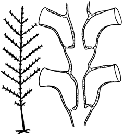WoRMS taxon details
Syntheciidae Marktanner-Turneretscher, 1890
- Genus Hincksella Billard, 1918
- Genus Synthecium Allman, 1872
- Genus Cyclonia Stechow, 1921 accepted as Hincksella Billard, 1918 (unaccepted > junior subjective synonym)
- Genus Parathuiaria Leloup, 1974 accepted as Thuiaria Fleming, 1828 (unaccepted > junior subjective synonym)
marine, brackish, fresh, terrestrial
recent only
Marktanner-Turneretscher, G. 1890. Hydroiden des K. & K. Naturhistorischen Hofmuseums. - Annalen des K. K. Naturhistorischen Hofmuseums 5: 195-286., available online at https://www.biodiversitylibrary.org/page/4047029 [details]
Schuchert, P.; Choong, H.; Galea, H.; Hoeksema, B.; Lindsay, D.; Manko, M.; Pica, D. (2025). World Hydrozoa Database. Syntheciidae Marktanner-Turneretscher, 1890. Accessed through: World Register of Marine Species at: https://www.marinespecies.org/aphia.php?p=taxdetails&id=22963 on 2025-07-16
Date
action
by
2004-12-21 15:54:05Z
created
db_admin
![]() The webpage text is licensed under a Creative Commons
Attribution 4.0 License
The webpage text is licensed under a Creative Commons
Attribution 4.0 License
Nomenclature
original description
Marktanner-Turneretscher, G. 1890. Hydroiden des K. & K. Naturhistorischen Hofmuseums. - Annalen des K. K. Naturhistorischen Hofmuseums 5: 195-286., available online at https://www.biodiversitylibrary.org/page/4047029 [details]
Other
context source (Hexacorallia)
Fautin, Daphne G. (2013). Hexacorallians of the World. (look up in IMIS) [details]
additional source Costello, M.J., C. Emblow & R. White (EdS.). (2001). European register of marine species: a check-list of the marine species in Europe and a bibliography of guides to their identification. <em>Collection Patrimoines Naturels, 50. Muséum national d'Histoire Naturelle: Paris, France.</em> 463 pp. (look up in IMIS) [details]
additional source Watson, J. E. (2000). Hydroids (Hydrozoa: Leptothecatae) from the Beagle Gulf and Darwin Harbour, northern Australia. <em>The Beagle, Records of the Museums and Art Galleries of the Northern Territory.</em> 16: 1-82.
note: revision of family [details] Available for editors [request]
[request]
additional source Costello, M.J., C. Emblow & R. White (EdS.). (2001). European register of marine species: a check-list of the marine species in Europe and a bibliography of guides to their identification. <em>Collection Patrimoines Naturels, 50. Muséum national d'Histoire Naturelle: Paris, France.</em> 463 pp. (look up in IMIS) [details]
additional source Watson, J. E. (2000). Hydroids (Hydrozoa: Leptothecatae) from the Beagle Gulf and Darwin Harbour, northern Australia. <em>The Beagle, Records of the Museums and Art Galleries of the Northern Territory.</em> 16: 1-82.
note: revision of family [details] Available for editors
From editor or global species database
Diagnosis Hydroid colony erect, arising from a creeping hydrorhiza, shoots unbranched or with stem and pinnately arranged hydrocladia, hydrothecae sessile, bilaterally symmetrical, in two or more longitudinal rows on hydrocaulus and hydrocladia, alternate or opposite, partly adnate, no real diaphragm but with perforated basal floor, hydrothecal rim even, operculum and nematophores absent; gonophore as fixed sporosacs, gonothecae arising from within hydrothecal cavity or from fenestrae below hydrothecae or from hydrorhiza. [details]
| Language | Name | |
|---|---|---|
| Japanese | ツツウミシバ科 | [details] |









